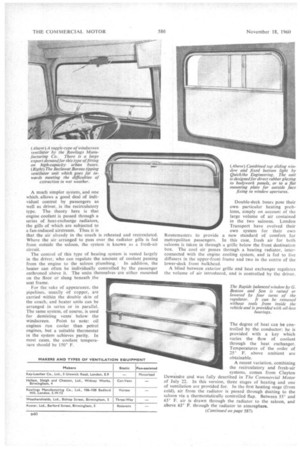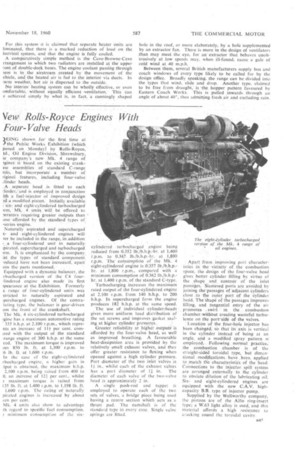take a tip from Telehoist
Page 75

Page 74

Page 79

If you've noticed an error in this article please click here to report it so we can fix it.
A much simpler system, and one which, allows a good deal of individual control by passengers as well as driver, is the recirculatory type. The theory here is that engine coolant is passed through a series of heat-exchange radiators, the gills of which are subjected to a fan-induced airstream. Thus it is that the air already in the coach is reheated and recirculated. Where the air arranged to pass over the radiator gills is fed from outside the saloon, the system is known as a fresh-air circuit.
The control of this type of heating system is vested largely in the driver, who can regulate the amount of coolant passing from the engine to the saloon plumbing. In addition, the heater can often be individually controlled by the passenger enthroned above it. The units themselves are either mounted on the floor or slung beneath the seat frame.
For the sake of appearance, the pipelines, usually of copper, are carried within the double skin of the coach, and heater units can be arranged in series or in parallel. The same system, of course, is used for demisting vents below the windscreen. Point to note: oil engines run cooler than petrol engines, but a suitable thermostat in the system achieves parity. In most cases, the coolant temperature should be 150° F.
Double-deck buses pose their own particular heating problems, simply on account of the large volume of air contained in the two saloons. London Transport have evolved their own system for their own Routemasters to provide a new standard of comfort for metropolitan passengers. In this ease, fresh air for both saloons is taken in through a grille below the front destination box. The cool air passes through a heating radiator, interconnected with the engine cooling system, and is fed to five diffusers in the upper-front frame and two in the centre of thelower-deck front bulkhead.
A blind between exterior grille and heat exchanger regulates the volume of air introduced, and is controlled by the driver.
The degree of heat can be controlled by the conductor; he is provided with a key which varies the flow of coolant through the heat exchanger. Temperatures of the order of 25° F. above ambient are obtainable.
A recent variation, combining the recirculatory and fresh-air systems, comes from Clayton Dewandre and was fully described in The Commercial Motor of July 22. In this version, three stages of heating and one of ventilation are provided for. In the first heating stage (from cold), air from the radiator is passed through ducting to the saloon via a thermostatically controlled flap. Between 550 and 65° F. air is drawn through the radiator to the saloon, and above 650 F. through the radiator to atmosphere. For this system it is claimed that separate heater units are liminatecl, that there is a marked reduCtion or load on the lectrical system, and that the engine is fully cooled. A comparatively simple method is the Cave-Browne-Cave rrangement in which two radiators are installed at the upper ront of double-deck buses. The engine coolant passing through tern is in the airstream created by the movement of the chicle, and the heated air is fed to the interior via ducts. In ,arm weather, hot air is dispersed to the outside. No interior heating system can be wholly effective, or even ontfortable; without equally efficient .ventilation. • This can e achieved simply by what is, in fact, a cunningly shaped hole in the roof, or more elaborately, by a hole supplemented by an extractor fan. There is more in the design of ventilators than may meet the eye, for an extractor that, behaves unobtrusively at low speeds may, when ill-found, cause a gale of cold wind at 40 m.p.h. Between them, several British manufacturers supply bus and coach windows of every type likely to be called for by the design office. Broadly speaking, the range can be divided into the types that wind, slide and drop. Another type. claimed to be free from draught, is -the, hopper pattern favoured by Eastern Coach Works. This is pulled inwards through an angle of about 40°, thus admitting fresh air and excluding rain.




































































































































